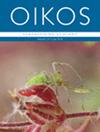在半自然草地上放牧脊椎动物可减轻养分添加对植物多样性和昆虫数量的影响
IF 3.1
2区 环境科学与生态学
Q2 ECOLOGY
引用次数: 0
摘要
人类引起的营养富营养化是草原生物多样性的一个主要威胁,因为它促使快速生长的植物占据主导地位。大型脊椎动物食草动物的放牧可能会抵消施肥对植物生物多样性的负面影响。然而,人们对食草动物是否也能减轻养分添加对昆虫的影响还知之甚少。我们利用一个野外实验来测试植物群落以及传粉昆虫和蚱蜢的数量如何对养分添加和不同大型食草动物群的放牧(即所有食草动物(包括牛和马)进入、仅野生食草动物(野猪和鹿)进入、大型食草动物不进入)做出反应。施肥后,植物生物量增加,植物多样性减少,群落组成转向较低的草本植物覆盖率,但仅限于没有所有食草动物的情况。膜翅目昆虫(蜜蜂和黄蜂),即最丰富的传粉昆虫群,只有在没有所有食草动物的情况下,才会因添加养分而减少探花量,并且与开花植物的丰富度呈正相关。相反,双翅目昆虫(如食蚜蝇)对花朵的造访会因施肥而增加,但不会受到放牧的影响。直翅目昆虫(蚱蜢)的数量因放牧而减少,因增加养分而增加,施肥对只有野生食草动物或没有食草动物的地块影响更大。蚱蜢的数量与草的生物量呈正相关。我们的结论是,脊椎动物食草动物可以抵消施肥对植物和昆虫群落的影响,因此大型哺乳动物放牧是保护昆虫,尤其是传粉昆虫的重要工具。只有在没有大型食草动物的地块中,对养分添加的反应才最为明显,这表明仅靠野生食草动物就能减轻养分的影响。我们还发现,在施肥和未放牧的条件下,昆虫的食性可能会截然不同。因此,在不同强度的放牧条件下创造一个马赛克斑块将提高昆虫的整体生物多样性。本文章由计算机程序翻译,如有差异,请以英文原文为准。
Vertebrate grazing can mitigateimpacts of nutrient addition on plant diversity and insect abundance in a semi‐natural grassland
Human‐induced nutrient eutrophication is a major threat to grassland biodiversity, because it promotes the dominance of fast‐growing plants. Negative impacts of fertilization on plant biodiversity may be offset by grazing by large vertebrate herbivores. However, whether grazers also mitigate impacts of nutrient addition on insects is less well understood. We use a field experiment to test how plant communities and abundances of pollinators and grasshoppers respond to nutrient addition and grazing by different assemblages of large herbivores, i.e. access by all herbivores (including cattle and horses), access by wild herbivores only (wild boar and deer), no access by large herbivores. Plant biomass increased, plant diversity decreased and community composition shifted towards lower forb cover in response to fertilization, but only in the absence of all herbivores. Flower visitation by Hymenoptera (bees and wasps), i.e. the most abundant pollinator group, was reduced by nutrient addition only in the absence of all herbivores and was positively related to flowering plant richness. In contrast, flower visitation by Diptera (e.g. hoverflies) was enhanced by fertilization, but not affected by grazing. Orthoptera (grasshopper) abundance was reduced by grazing and enhanced by nutrient addition, with positive impacts of fertilization tending to be stronger in plots with only wild or no herbivores. The abundance of grasshoppers was positively related to grass biomass. We conclude that vertebrate herbivores can offset impacts of fertilization on both plant and insect communities, making grazing by large mammals an essential tool to protect insects, particularly pollinators. Most responses to nutrient addition were only apparent in plots without any large herbivores, suggesting that wild herbivores alone could already mitigate nutrient impacts. We also show that insects with contrasting feeding guilds may be favoured by fertilized, ungrazed conditions. Therefore, creating a mosaic of patches grazed at different intensities will enhance overall insect biodiversity.
求助全文
通过发布文献求助,成功后即可免费获取论文全文。
去求助
来源期刊

Oikos
环境科学-生态学
CiteScore
6.20
自引率
5.90%
发文量
152
审稿时长
6-12 weeks
期刊介绍:
Oikos publishes original and innovative research on all aspects of ecology, defined as organism-environment interactions at various spatiotemporal scales, so including macroecology and evolutionary ecology. Emphasis is on theoretical and empirical work aimed at generalization and synthesis across taxa, systems and ecological disciplines. Papers can contribute to new developments in ecology by reporting novel theory or critical empirical results, and "synthesis" can include developing new theory, tests of general hypotheses, or bringing together established or emerging areas of ecology. Confirming or extending the established literature, by for example showing results that are novel for a new taxon, or purely applied research, is given low priority.
 求助内容:
求助内容: 应助结果提醒方式:
应助结果提醒方式:


